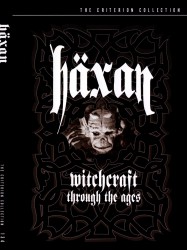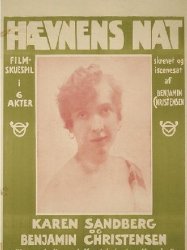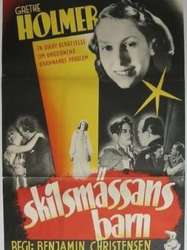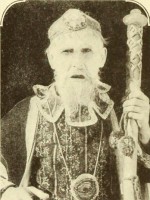Benjamin Christensen est un Acteur, Réalisateur, Scénariste, Producteur, Monteur et Créateur de production Danois né le 28 septembre 1879 à Viborg (Danemark)

Benjamin Christensen est un réalisateur danois, né le 28 septembre 1879 à Viborg et décédé le 2 avril 1959 à Copenhague.
Considéré avec Carl Theodor Dreyer comme le maître du cinéma muet danois, il est aujourd'hui oublié, du moins en France, excepté par son œuvre-phare La Sorcellerie à travers les âges. Il réalisa également sept films aux États-Unis.
In 1913, Christensen assumed control of the small, Hellborg-based production company for which he worked and reorganized it as Dansk-Biograf Kompagnie. The first film he directed, Det hemmelighedsfulde X (The Mysterious X, 1914), was one of the most astonishing directorial debuts in film history; although a routine spy melodrama, the camerawork, cutting and art direction were revolutionary for the period. Christensen himself played the main role, as he did in his second film, Hævnens nat (Blind Justice, 1916). Once again, Christensen portrayed a man wrongly accused of murder, and the artistic quality of his sophomore effort was equal to his first. Despite the success of his first two films, Christensen did not find acceptance within the Danish film industry, and after Blind Justice he returned to the stage.
Between 1918 and 1921, Christensen researched the history of necromancy as background for his next and greatest film, Häxan (The Witches, or Witchcraft Through the Ages, 1922), in which Christensen appeared in the role of Satan. A plotless panorama of the history of witchcraft, Häxan is a visual tour de force that utilizes nudity, gore and sheer shock value on a level that remains incredible for a silent film; nevertheless, despite being plundered by censor boards everywhere, Häxan was an international success. Based on the response to Häxan, Christensen received an invitation from UFA to direct in Germany. He made two films for them, though Christensen's most memorable work in Germany was as an actor in the key supporting role of the painter Claude Zoret in his fellow countryman Carl Theodor Dreyer's film Michael (1924). This would prove Christensen's last film appearance as an actor.
In 1924, M-G-M swept through the talent pool at UFA and picked up, among others, Christensen, who departed so quickly that he may not have completed his second feature, Die Frau mit dem schlechten Ruf (The Woman of Ill-Repute, 1925); it wasn't released until the end of 1925 and by that time Christensen had already disowned it. Christensen got off a good start with the Norma Shearer vehicle The Devil's Circus (1926), a commercial success. But the Lon Chaney picture Mockery (1927) which followed was a scandalous failure critically, even as it still generated a modest profit. When work stalled in 1927 on M-G-M's troubled, three-years-long production of The Mysterious Island (1929), Christensen was let go. He moved to Warner Brothers, where he made four films; the first was The Hawk's Nest (1928), a crime drama starring Milton Sills. The remaining three constitute a horror trilogy and were co-written with Cornell Woolrich; The Haunted House (1928), Seven Footprints to Satan (1929) and House of Horror (1929). By this time, Christensen had had enough of his Hollywood experience and although House of Horror was a hit, after it wrapped he went back to Denmark.
Afterward, Christensen returned once again to stage direction and did not make another film for a decade. Breaking his silence, for the Nordisk Company he wrote and directed Skilsmissens børn (Children of Divorce, 1939), a social melodrama about the generation gap; it was a surprise hit, and Christensen seemed back on track again. He followed it with Barnet (The Child, 1940) – a film about abortion – and Gå med mig hjem (Come Home with Me, 1941) which reunited him with actress Bodil Ipsen, who had appeared alongside Christensen in the Bjørnson film and was herself a director. However, Damen med de lyse Handsker (The Lady with the Light Gloves, 1942) was a spy thriller that proved an unmitigated disaster on the level of Mockery, and Christensen found himself out of the film business for good. Afterward, he assumed management of a movie theater in a suburb of Copenhagen and lived out the rest of his 79 years in obscurity.
Source : Wikidata
Benjamin Christensen

- Infos
- Photos
- Meilleurs films
- Famille
- Personnages
- Récompenses
Nationalité Danemark
Naissance 28 septembre 1879 à Viborg (Danemark)
Mort 2 avril 1959 (à 79 ans) à Copenhague (Danemark)
Naissance 28 septembre 1879 à Viborg (Danemark)
Mort 2 avril 1959 (à 79 ans) à Copenhague (Danemark)
Benjamin Christensen est un réalisateur danois, né le 28 septembre 1879 à Viborg et décédé le 2 avril 1959 à Copenhague.
Considéré avec Carl Theodor Dreyer comme le maître du cinéma muet danois, il est aujourd'hui oublié, du moins en France, excepté par son œuvre-phare La Sorcellerie à travers les âges. Il réalisa également sept films aux États-Unis.
Biographie
Benjamin Christensen was born in Viborg and initially studied medicine, but caught the acting bug and began studies at the Det Kongelige Teater (Royal Danish Theatre) in Copenhagen in 1901. Christensen's professional acting career began in Aarhus in 1907, but after a short stint as actor he abandoned the stage in order to become a wine salesman. In 1911, Christensen made his debut as a film actor; all of his pre-directorial efforts are lost, but among such films was Scenens børn (1913), the only motion picture directed by eminent Norwegian playwright and stage director Bjørn Bjørnson.In 1913, Christensen assumed control of the small, Hellborg-based production company for which he worked and reorganized it as Dansk-Biograf Kompagnie. The first film he directed, Det hemmelighedsfulde X (The Mysterious X, 1914), was one of the most astonishing directorial debuts in film history; although a routine spy melodrama, the camerawork, cutting and art direction were revolutionary for the period. Christensen himself played the main role, as he did in his second film, Hævnens nat (Blind Justice, 1916). Once again, Christensen portrayed a man wrongly accused of murder, and the artistic quality of his sophomore effort was equal to his first. Despite the success of his first two films, Christensen did not find acceptance within the Danish film industry, and after Blind Justice he returned to the stage.
Between 1918 and 1921, Christensen researched the history of necromancy as background for his next and greatest film, Häxan (The Witches, or Witchcraft Through the Ages, 1922), in which Christensen appeared in the role of Satan. A plotless panorama of the history of witchcraft, Häxan is a visual tour de force that utilizes nudity, gore and sheer shock value on a level that remains incredible for a silent film; nevertheless, despite being plundered by censor boards everywhere, Häxan was an international success. Based on the response to Häxan, Christensen received an invitation from UFA to direct in Germany. He made two films for them, though Christensen's most memorable work in Germany was as an actor in the key supporting role of the painter Claude Zoret in his fellow countryman Carl Theodor Dreyer's film Michael (1924). This would prove Christensen's last film appearance as an actor.
In 1924, M-G-M swept through the talent pool at UFA and picked up, among others, Christensen, who departed so quickly that he may not have completed his second feature, Die Frau mit dem schlechten Ruf (The Woman of Ill-Repute, 1925); it wasn't released until the end of 1925 and by that time Christensen had already disowned it. Christensen got off a good start with the Norma Shearer vehicle The Devil's Circus (1926), a commercial success. But the Lon Chaney picture Mockery (1927) which followed was a scandalous failure critically, even as it still generated a modest profit. When work stalled in 1927 on M-G-M's troubled, three-years-long production of The Mysterious Island (1929), Christensen was let go. He moved to Warner Brothers, where he made four films; the first was The Hawk's Nest (1928), a crime drama starring Milton Sills. The remaining three constitute a horror trilogy and were co-written with Cornell Woolrich; The Haunted House (1928), Seven Footprints to Satan (1929) and House of Horror (1929). By this time, Christensen had had enough of his Hollywood experience and although House of Horror was a hit, after it wrapped he went back to Denmark.
Afterward, Christensen returned once again to stage direction and did not make another film for a decade. Breaking his silence, for the Nordisk Company he wrote and directed Skilsmissens børn (Children of Divorce, 1939), a social melodrama about the generation gap; it was a surprise hit, and Christensen seemed back on track again. He followed it with Barnet (The Child, 1940) – a film about abortion – and Gå med mig hjem (Come Home with Me, 1941) which reunited him with actress Bodil Ipsen, who had appeared alongside Christensen in the Bjørnson film and was herself a director. However, Damen med de lyse Handsker (The Lady with the Light Gloves, 1942) was a spy thriller that proved an unmitigated disaster on the level of Mockery, and Christensen found himself out of the film business for good. Afterward, he assumed management of a movie theater in a suburb of Copenhagen and lived out the rest of his 79 years in obscurity.
Le plus souvent avec
Filmographie de Benjamin Christensen (17 films)
Acteur

Michaël (1924)
Réalisé par Carl Theodor Dreyer
Origine Allemagne
Genres Drame, Romance
Thèmes Peinture, Sexualité, Homosexualité, LGBT, LGBT
Acteurs Benjamin Christensen, Walter Slezak, Nora Gregor, Alexander Murski, Grete Mosheim, Karl Freund
Rôle Claude Zoret
Note70%





Dans la vaste demeure du peintre Claude Zoret, Michaël, son modèle préféré devenu son fils adoptif, montre à d'élégants invités un de ses tableaux. La princesse Zamikoff vient demander au maître de faire son portrait. Elle devient, par la suite, la séductrice du jeune Michaël. Le journaliste Switt tente d'instruire Claude Zoret de l'attitude de son protégé. Or, celui-ci, revenu au foyer, use de flatteries trompeuses pour emprunter au peintre de fortes sommes d'argent ; plus tard, il lui volera même une de ses œuvres les plus remarquables. Zoret finit par lui pardonner et en fait son légataire universel. Gravement malade, Claude Zoret s'éteint dans une profonde solitude, le cœur certes déçu mais encore plein d'indulgence.
 , 1h27
, 1h27Réalisé par Benjamin Christensen
Origine Danemark
Genres Drame, Documentaire, Fantasy, Horreur, Historique
Thèmes Magie, Maladie, Religion, Sexualité, Erotique, Sexploitation, Diable, Mise en scène d'une sorcière, Folie, Nonnesploitation
Acteurs Clara Pontoppidan, Oscar Stribolt, Benjamin Christensen, Elith Pio, Astrid Holm, Tora Teje
Rôle Le Diable
Note75%





Présenté à la manière d'une conférence, Häxan est un essai filmique sur le sujet de la sorcellerie, de l'antiquité à une période contemporaine du film (1922).

Nuit de justice (1916)
, 1h40Réalisé par Benjamin Christensen
Origine Danemark
Genres Drame, Thriller, Horreur, Policier
Acteurs Benjamin Christensen, Jon Iversen, Charles Wilken, Mathilde Nielsen, Elith Pio, Osvald Helmuth
Rôle "Strong" Henry/John
Note66%





La veille du Nouvel An, le meurtrier Strong Henry s'évade de prison et va chercher son fils à l'orphelinat. Lorsqu'il s'introduit dans un manoir local pour y chercher du lait pour son enfant, il est surpris par une jeune femme, Eva. Par pitié, elle décide d'aider l'étranger, mais malheureusement, les autres occupants du manoir se réveillent et appellent la police. Quatorze ans plus tard, Henry sort de prison. Convaincu qu'Eva l'a trahi, il entreprend de se venger et de retrouver son fils.

Le Mystérieux X (1914)
, 1h24Réalisé par Benjamin Christensen
Origine Danemark
Genres Drame
Thèmes Espionnage
Acteurs Benjamin Christensen, Bjørn Spiro, Svend Rindom, Robert Schmidt
Rôle Lieutenant van Hauen
Note67%





Un officier de marine est accusé à tort d'espionnage, et celui qui l'a fait accuser tente de faire chanter sa femme.
Réalisateur

Damen med de lyse handsker (1942)
, 1h21Réalisé par Benjamin Christensen
Origine Danemark
Genres Drame
Acteurs Lily Weiding, Hans-Henrik Krause, Karl Jørgensen, Jessie Rindom, Olaf Ussing, Bjarne Henning-Jensen
Note49%






Gaa med mig hjem (1941)
, 1h30Réalisé par Benjamin Christensen
Origine Danemark
Genres Drame
Acteurs Bodil Ipsen, Johannes Meyer, Grethe Holmer, Eigil Reimers, Mogens Wieth, Helga Frier
Note31%






Barnet (1940)
, 1h25Réalisé par Benjamin Christensen
Origine Danemark
Genres Drame, Comédie
Acteurs Bjarne Forchhammer, Beatrice Bonnesen, Mogens Wieth, Inger Lassen, Gunnar Lauring, Helga Frier
Note61%






Skilsmissens børn (1939)
, 1h31Réalisé par Benjamin Christensen
Origine Danemark
Genres Drame
Acteurs Grethe Holmer, Johannes Meyer, Mathilde Nielsen, Johannes Meyer, Jeanne Darville, Carlo Wieth
Note33%






L'Île mystérieuse (1929)
, 1h35Réalisé par Benjamin Christensen, Maurice Tourneur, Lucien Hubbard
Origine Etats-Unis
Genres Drame, Science-fiction, Fantasy, Action, Aventure, Horreur, Romance
Thèmes La mer, Transport, Action sous-marine, Guerre en milieu sous-marin, Pirates, Adaptation d'une œuvre littéraire de science-fiction, Politique
Acteurs Lionel Barrymore, Jacqueline Gadsden, Montagu Love, Lloyd Hughes, Harry Gribbon, Snitz Edwards
Note60%





Le Comte Dakkar, un scientifique et dirigeant bénévole qui a ôté toute distinction de classe sociale parmi les habitants de l'île, gouverne sur une île volcanique proche du royaume Hetvia. Dakkar, sa fille Sonia et son fiancé, l'ingénieur Nicolai Roget, ont dessiné un sous-marin que Roget pilote. Jusqu'au jour où l'île est envahie par le Baron Falon, gouverneur despotique d'Hetvia. Falon poursuit Roget dans un second sous-marin. Les deux équipages découvrent sous les fonds de l'océan un étrange pays peuplé de dragons, de calamars géants et d'une étrange race humanoïde encore inconnue.
 , 1h
, 1hRéalisé par Benjamin Christensen
Origine Etats-Unis
Genres Comédie, Comédie dramatique, Comédie horrifique, Horreur, Policier
Thèmes Fantômes, Comédie horrifique
Acteurs Thelma Todd, Creighton Hale, William V. Mong, Sheldon Lewis, Sōjin Kamiyama, DeWitt Jennings
Note65%





Un aventurier et sa fiancée se retrouvent séquestrés dans une inquiétante maison peuplée de créatures étranges qui pratiquent des rites sataniques.

House of Horror (1929)
, 1h5Réalisé par Benjamin Christensen
Origine Etats-Unis
Genres Comédie, Comédie horrifique, Horreur
Thèmes Comédie horrifique
Acteurs Louise Fazenda, Chester Conklin, Thelma Todd, William V. Mong, Émile Chautard, William Orlamond
Note61%






The Hawk's Nest (1928)
Réalisé par Benjamin Christensen
Origine Etats-Unis
Genres Drame
Acteurs Milton Sills, Doris Kenyon, Sōjin Kamiyama, Montagu Love, Mitchell Lewis, Stuart Holmes
The title of The Hawk's Nest comes from the speakeasy around which most of the action revolves. Two bootleggers, played by Milton Sills and Mitchell Lewis, quarrel over a dancer (Doris Kenyon) while a political assassination plot.

The Haunted House (1928)
, 1h10Réalisé par Benjamin Christensen
Origine Etats-Unis
Genres Drame, Comédie, Comédie dramatique, Horreur
Thèmes Adaptation d'une pièce de théâtre
Acteurs Larry Kent, Thelma Todd, Edmund Breese, Sidney Bracey, Barbara Bedford, Flora Finch
Note66%






Mockery (1927)
, 1h15Réalisé par Benjamin Christensen
Origine Etats-Unis
Genres Drame, Romance
Thèmes Politique
Acteurs Lon Chaney, Barbara Bedford, Ricardo Cortez, Emily Fitzroy, Mack Swain, John Mack Brown
Note67%






Le Cirque du diable (1926)
, 1h10Réalisé par Benjamin Christensen
Origine Etats-Unis
Genres Drame
Thèmes Cirque, Religion, Diable
Acteurs Norma Shearer, Charles Emmett Mack, Carmel Myers, John Miljan, Claire McDowell, Charles Murray
Note65%





Mary and Carlstop are a trapeze artist and a pickpocket who get themselves almost fatally involved with Lieberkind, a lion-tamer, and his jealous wife Yonna.
 Connexion
Connexion




